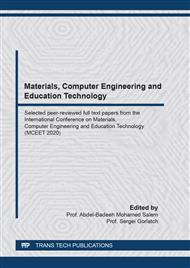p.110
p.119
p.125
p.137
p.144
p.151
p.161
p.167
p.172
Crack Identification of Curved-Elements Using Wavelet Packet
Abstract:
Wavelet Transform (WT) and Wavelet Packet Transform (WPT) approaches have shown great promise in the field of signal analysis in recent decades. The main merit of these methods is their capability in localization of each signal in distinct time or space interval. However, the frequency resolution of such transformation is relatively poor in high frequency regions. The WPT, which is an extended form of the WT, provides a complete level-by-level signal decomposition. Therefore, a frequency analysis creates an arbitrary time. In this study, dynamic transient analysis is performed employing a finite element software (ANSYS) on a beam and acceleration time history of various points is investigated. Then, the captured signals are decomposed to the wavelet packet components using MATLAB and energy rate index is calculated for each component utilizing a wavelet packet rate index (WPERI). The results indicate that not only are the obtained index values sensitive, but they also are precise for the crack identification.
Info:
Periodical:
Pages:
144-150
Citation:
Online since:
April 2021
Authors:
Price:
Сopyright:
© 2021 Trans Tech Publications Ltd. All Rights Reserved
Share:
Citation:


